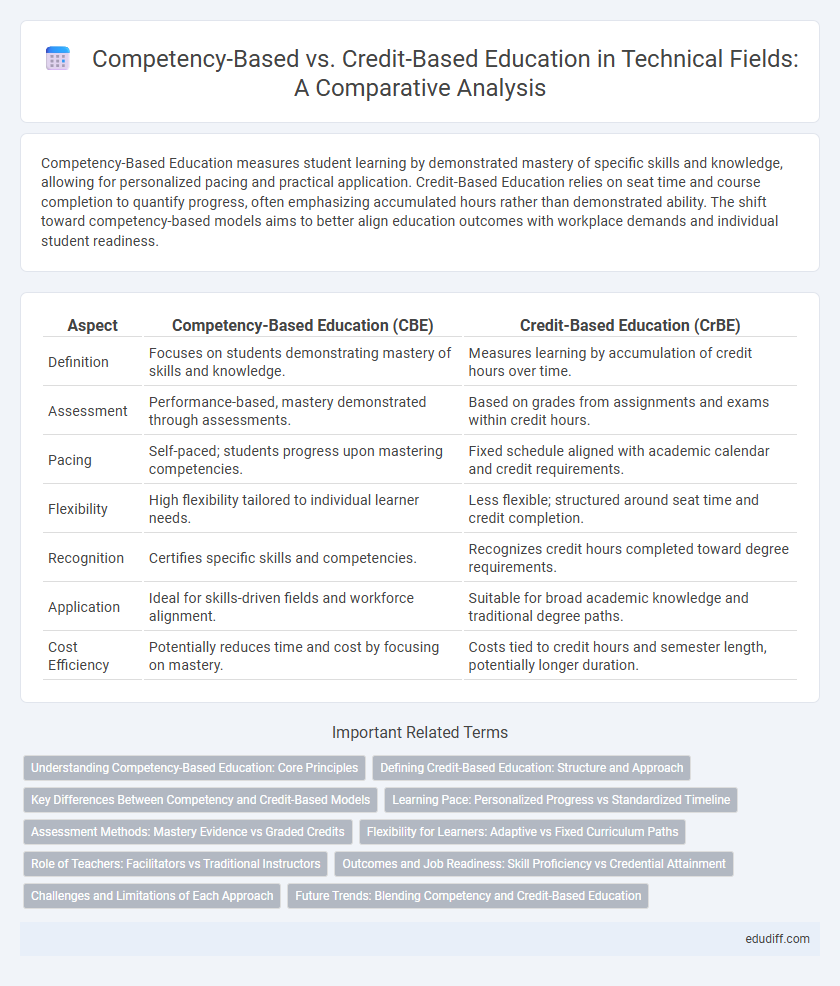Competency-Based Education measures student learning by demonstrated mastery of specific skills and knowledge, allowing for personalized pacing and practical application. Credit-Based Education relies on seat time and course completion to quantify progress, often emphasizing accumulated hours rather than demonstrated ability. The shift toward competency-based models aims to better align education outcomes with workplace demands and individual student readiness.
Table of Comparison
| Aspect | Competency-Based Education (CBE) | Credit-Based Education (CrBE) |
|---|---|---|
| Definition | Focuses on students demonstrating mastery of skills and knowledge. | Measures learning by accumulation of credit hours over time. |
| Assessment | Performance-based, mastery demonstrated through assessments. | Based on grades from assignments and exams within credit hours. |
| Pacing | Self-paced; students progress upon mastering competencies. | Fixed schedule aligned with academic calendar and credit requirements. |
| Flexibility | High flexibility tailored to individual learner needs. | Less flexible; structured around seat time and credit completion. |
| Recognition | Certifies specific skills and competencies. | Recognizes credit hours completed toward degree requirements. |
| Application | Ideal for skills-driven fields and workforce alignment. | Suitable for broad academic knowledge and traditional degree paths. |
| Cost Efficiency | Potentially reduces time and cost by focusing on mastery. | Costs tied to credit hours and semester length, potentially longer duration. |
Understanding Competency-Based Education: Core Principles
Competency-Based Education (CBE) centers on mastery of specific skills and knowledge rather than time spent in class, allowing students to progress at their own pace upon demonstrating proficiency. Core principles include personalized learning paths, clear and measurable learning outcomes, and performance-based assessment methods that emphasize real-world application. This approach contrasts with Credit-Based Education, which primarily relies on credit hours and seat time as indicators of academic progress.
Defining Credit-Based Education: Structure and Approach
Credit-Based Education organizes learning into predefined credit units tied to specific courses, emphasizing seat time and syllabus completion for degree progression. This structure enables standardized assessment through accumulated credits that reflect academic achievement over fixed periods. The approach prioritizes chronological learning milestones, facilitating quantifiable measurement of student progress within traditional academic frameworks.
Key Differences Between Competency and Credit-Based Models
Competency-Based Education (CBE) emphasizes mastery of skills and knowledge demonstrated through assessments, allowing students to progress at their own pace, while Credit-Based Education relies on accumulating fixed credit hours from completed courses within set timeframes. CBE prioritizes personalized learning and real-world application, with success measured by demonstrated competencies rather than time spent in class, contrasting with the traditional credit-hour accumulation metric. This key difference fundamentally shifts the evaluation from seat time to demonstrable expertise and practical proficiency in CBE.
Learning Pace: Personalized Progress vs Standardized Timeline
Competency-Based Education (CBE) allows learners to progress at an individualized pace by demonstrating mastery of specific skills, while Credit-Based Education follows a fixed timeline structured around credit hours and semesters. CBE's personalized progression adapts to each student's learning speed, promoting deeper understanding and efficient skill acquisition. In contrast, the standardized timeline in credit-based systems may cause some students to advance before full mastery or remain stagnant due to rigid scheduling.
Assessment Methods: Mastery Evidence vs Graded Credits
Competency-Based Education employs mastery evidence through performance-based assessments, ensuring learners demonstrate practical skills and knowledge before progressing. Credit-Based Education relies on graded credits tied to seat time and coursework completion, often emphasizing theoretical understanding over applied mastery. This shift towards competency-based assessment offers more precise measurement of learner proficiency and real-world readiness.
Flexibility for Learners: Adaptive vs Fixed Curriculum Paths
Competency-Based Education (CBE) offers adaptive curriculum paths tailored to individual learner progress, enabling flexibility in mastering skills at their own pace. Credit-Based Education relies on fixed curriculum paths with predefined course sequences and credit requirements, limiting learner customization. This adaptability in CBE supports diverse learning styles and accelerates competency acquisition compared to the rigid structure of traditional credit systems.
Role of Teachers: Facilitators vs Traditional Instructors
In competency-based education, teachers serve primarily as facilitators who guide individualized learning paths and assess mastery of specific skills, emphasizing personalized support and practical application. In contrast, traditional credit-based education positions teachers as instructors delivering standardized content and evaluating student performance through time-based assessments such as exams and assignments. The shift from instructor-led to facilitator-driven roles requires educators to adopt adaptive mentoring techniques and leverage formative assessments to ensure competency achievement.
Outcomes and Job Readiness: Skill Proficiency vs Credential Attainment
Competency-Based Education (CBE) emphasizes skill proficiency and measurable outcomes, ensuring learners demonstrate specific competencies critical for job readiness before progressing. In contrast, Credit-Based Education primarily focuses on credential attainment through credit accumulation, often without direct assessment of practical skill mastery. This outcome-oriented approach in CBE aligns more closely with employer expectations, promoting workforce relevance and effective skill application.
Challenges and Limitations of Each Approach
Competency-Based Education (CBE) faces challenges in standardizing assessment criteria and ensuring consistent competency measurement across diverse learners, often requiring significant technological infrastructure and faculty training. Credit-Based Education (CrBE) struggles with rigid time-based structures that may not reflect actual mastery, leading to potential gaps in skill acquisition and limited flexibility for individualized learning paces. Both approaches encounter limitations in scalability, resource allocation, and aligning educational outcomes with industry demands, necessitating ongoing adaptation to evolving workforce requirements.
Future Trends: Blending Competency and Credit-Based Education
Future trends in education highlight the integration of competency-based education (CBE) with credit-based systems to enhance personalized learning pathways. This hybrid model leverages mastery of skills and knowledge while maintaining standardized credit accumulation for degree progression. Institutions adopting this approach demonstrate improved learner engagement and better alignment with workforce demands through flexible, outcomes-driven curricula.
Competency-Based Education vs Credit-Based Education Infographic

 edudiff.com
edudiff.com